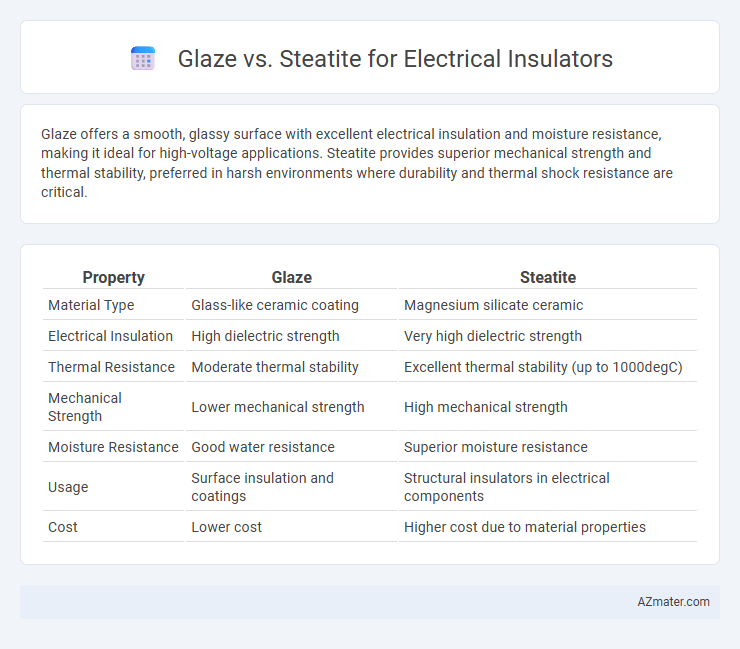Glaze offers a smooth, glassy surface with excellent electrical insulation and moisture resistance, making it ideal for high-voltage applications. Steatite provides superior mechanical strength and thermal stability, preferred in harsh environments where durability and thermal shock resistance are critical.
Table of Comparison
| Property | Glaze | Steatite |
|---|---|---|
| Material Type | Glass-like ceramic coating | Magnesium silicate ceramic |
| Electrical Insulation | High dielectric strength | Very high dielectric strength |
| Thermal Resistance | Moderate thermal stability | Excellent thermal stability (up to 1000degC) |
| Mechanical Strength | Lower mechanical strength | High mechanical strength |
| Moisture Resistance | Good water resistance | Superior moisture resistance |
| Usage | Surface insulation and coatings | Structural insulators in electrical components |
| Cost | Lower cost | Higher cost due to material properties |
Introduction to Electrical Insulators
Electrical insulators are critical components designed to resist the flow of electric current, ensuring safety and efficiency in electrical systems. Glaze offers a smooth, glass-like surface with high dielectric strength and excellent resistance to moisture, making it ideal for high-voltage applications. Steatite, a dense ceramic composed primarily of talc, provides superior mechanical strength and thermal stability, favoring environments with mechanical stress or temperature fluctuations.
Glaze Overview: Composition and Properties
Glaze electrical insulators consist primarily of a glassy coating formed from silica, alumina, and fluxing agents, providing a smooth, glossy surface that enhances waterproofing and resistance to contaminants. The vitrified glaze layer offers excellent dielectric strength, mechanical durability, and resistance to thermal shock, making it ideal for high-voltage applications. These properties ensure stable performance in harsh environmental conditions, reducing maintenance and improving the longevity of electrical insulators.
Steatite Overview: Composition and Properties
Steatite, primarily composed of talc (magnesium silicate), is a ceramic material prized for its excellent electrical insulation, high thermal resistance, and mechanical strength, making it ideal for electrical insulators. Its dielectric strength surpasses many traditional materials, ensuring minimal electrical conductivity and superior performance in high-voltage applications. Steatite's low porosity and chemical stability further enhance durability and longevity in harsh industrial environments.
Electrical Performance Comparison
Glaze and steatite differ significantly in electrical performance as insulators, with steatite exhibiting superior dielectric strength typically around 12-15 kV/mm compared to glazed ceramics, which generally range from 7-10 kV/mm. Steatite's low dielectric loss and high resistivity make it ideal for high-frequency and high-voltage applications, whereas glaze coatings can sometimes introduce micro-defects that lower electrical reliability. The choice between glaze and steatite insulators depends on the required electrical insulation properties, with steatite preferred for demanding environments requiring robust electrical insulation.
Mechanical Strength and Durability
Steatite exhibits higher mechanical strength and durability compared to glaze, making it more suitable for high-stress electrical insulators in industrial applications. The dense, homogenous microstructure of steatite provides superior resistance to mechanical shock, abrasion, and thermal cycling, enhancing overall longevity. In contrast, glaze coatings can be brittle and prone to cracking under mechanical strain, reducing their effectiveness as a durable insulator in demanding environments.
Thermal Stability and Heat Resistance
Glaze and steatite exhibit distinct thermal stability and heat resistance properties essential for electrical insulators in high-temperature applications. Steatite offers superior thermal stability with a high melting point around 1700degC, excellent heat resistance, and low thermal expansion, making it ideal for harsh thermal environments. Glaze, while enhancing surface insulation and protection, has lower heat resistance and may degrade under extreme thermal stress, limiting its use in demanding electrical insulation scenarios.
Moisture Absorption and Environmental Impact
Glaze offers superior moisture resistance compared to steatite, making it ideal for electrical insulators exposed to humid conditions, as its low moisture absorption enhances dielectric strength and longevity. Steatite, while slightly more porous, provides excellent thermal stability but requires protective coatings to minimize moisture ingress and maintain insulating properties. Environmentally, glaze manufacturing involves higher energy consumption due to firing processes, whereas steatite, derived from natural talc, has a lower ecological footprint but may necessitate more frequent replacements due to moisture-related degradation.
Cost Analysis and Manufacturing Considerations
Glaze insulators typically offer lower initial manufacturing costs due to simpler production processes and more abundant raw materials, making them economically advantageous for high-volume applications. Steatite, a type of ceramic insulator composed of magnesium silicate, exhibits higher material and fabrication expenses driven by precise processing and longer firing cycles, but provides superior thermal stability and mechanical strength. Manufacturers must balance cost-efficiency against performance requirements, with glaze favored in budget-sensitive projects and steatite selected when enhanced durability and electrical insulation properties justify the premium investment.
Typical Applications in Electrical Systems
Glaze insulators are commonly used in high-voltage outdoor applications such as transformers, power lines, and switchgear due to their excellent weather resistance and arc-quenching properties. Steatite insulators are preferred in domestic electrical components, ceramic fuses, and low-voltage circuit breakers because of their superior thermal stability and electrical insulation in compact designs. Both materials contribute to reliable performance in electrical systems by optimizing insulation, durability, and temperature management based on specific application requirements.
Choosing the Right Material: Glaze vs Steatite
Choosing between glaze and steatite for electrical insulators depends on factors like dielectric strength, mechanical durability, and environmental resistance. Glaze offers high insulation efficiency with a smooth, impermeable surface ideal for outdoor applications exposed to moisture and pollutants. Steatite excels in mechanical strength and thermal stability, making it suitable for high-stress environments requiring robust insulator materials.

Infographic: Glaze vs Steatite for Electrical Insulator
 azmater.com
azmater.com